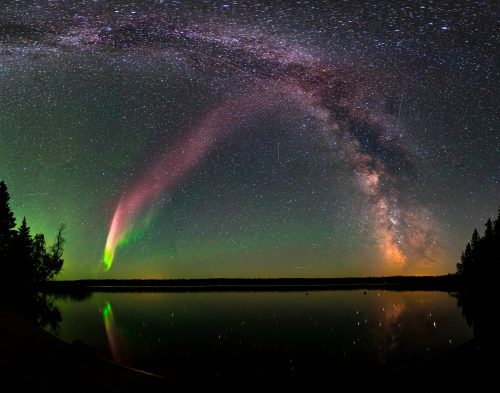It's Official: The Strange, Aurora-Like STEVE Is a Completely Unique Celestial Phenomenon

As the northern lights danced and glowed in the night sky this past Labor Day weekend, skywatchers in places like Alaska and Canada may have spotted a rose-tinted streak amidst the dazzling display. But this pink-ish ribbon isn't an aurora — it's STEVE!
STEVE (the Strong Thermal Emissions Velocity Enhancement) is a spectacular and colorful celestial phenomenon that was first spotted 2016. Scientists have studied the particles associated with STEVE for decades, but only recently have they witnessed the phenomenon in the sky. This past summer, a research team led by University of Calgary researcher D.M. Gillies confirmed that, despite its colorful appearance, STEVE isn't a type of aurora but something entirely unique.
In May, researchers confirmed that STEVE is not an aurora. But this new research expands our understanding of the strange phenomenon even further.
Related: Meet 'STEVE,' the Mystery Scientists Are Beginning to Unravel
"The big thing is, we can clearly say now it's [a] not regular aurora," study co-author Don Hampton, a researcher at the University of Alaska Fairbanks, said in a statement. "It's a new phenomenon; that's pretty exciting."
One characteristic that distinguishes STEVE is its mauve hues, which are different from the typically green, purple, blue and yellow beams of auroras. Additionally, STEVE is visible from latitudes much farther south than auroras usually are.
The researchers used a spectrograph, which they built at the Geophysical Institute at the University of Alaska Fairbanks, to study the light coming from STEVE which they observed on April 10, 2018 at Lucky Lake in Saskatchewan, Canada. They analyzed its emissions to determine its wavelengths, patterns and other properties. A spectrum acts as an identifier, so by determining STEVE's spectrum, the team hopes to further understand and categorize the phenomenon.
Get the Space.com Newsletter
Breaking space news, the latest updates on rocket launches, skywatching events and more!
"We need to understand what the spectrum looks like and therefore understand the physics behind it," Hampton said in the statement.
Green optical structures, often described as "picket fence" structures because of their distinctive shape, can be seen jutting through STEVE at lower altitudes, and in studying the wavelengths of the emissions from STEVE and these green structures, the team found that the green emissions have a much different spectrum from STEVE.
The team determined that the green columns which appear alongside STEVE are caused by particle precipitation, which occurs when energetic particles like electrons, protons, neutrons and ions are accelerated through the atmosphere. This makes these green streaks a type of aurora very similar to a typical auroral structure. However, because they have a very different spectrum, STEVE is in a category of its own, the researchers concluded.
The team found that STEVE isn't caused by particle collisions in the atmosphere but rather some sort of warm atmospheric emission.
"When we looked at the spectrum of STEVE, it had none of those distinct wavelengths … Instead, it's a very broad band of light," Hampton said in the statement. "When you turn your electric stove on, those coils get red hot, right? If you look at it with a spectrograph, you would see broadband emissions … So this is like very, very warm atmosphere emissions of some sort."
Scientists will continue to study STEVE, what exactly it is and what causes it. Understanding STEVE is more than just an important scientific pursuit, however. Phenomena in the atmosphere can disrupt radio communications between spacecraft and humans back on Earth, so understanding this strange, pink phenomenon could have immediate, practical applications.
This research was published in a study in the journal Geophysical Research Letters.
- An Aurora Called 'Steve'? Strange Sky Phenomenon Investigated
- Amazing Auroras: Photos of Earth's Northern Lights
- That Weird, Aurora-Like Phenomenon Called STEVE Finally Has an Explanation
Follow Chelsea Gohd on Twitter @chelsea_gohd. Follow us on Twitter @Spacedotcom and on Facebook.
Join our Space Forums to keep talking space on the latest missions, night sky and more! And if you have a news tip, correction or comment, let us know at: community@space.com.

Chelsea “Foxanne” Gohd joined Space.com in 2018 and is now a Senior Writer, writing about everything from climate change to planetary science and human spaceflight in both articles and on-camera in videos. With a degree in Public Health and biological sciences, Chelsea has written and worked for institutions including the American Museum of Natural History, Scientific American, Discover Magazine Blog, Astronomy Magazine and Live Science. When not writing, editing or filming something space-y, Chelsea "Foxanne" Gohd is writing music and performing as Foxanne, even launching a song to space in 2021 with Inspiration4. You can follow her on Twitter @chelsea_gohd and @foxannemusic.









